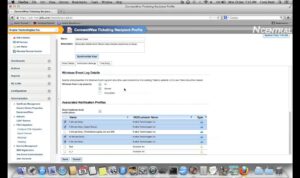The connectwise ticketing system is an essential tool in modern customer service and IT support frameworks, transforming how businesses manage requests and streamline operations. By centralizing communication, it allows teams to prioritize and resolve issues efficiently, ensuring customer satisfaction and improved response times. As organizations face increasing demands for quick and effective support, this system has become integral in maintaining productivity and service quality, creating a seamless experience for both clients and support staff.
This system not only organizes requests but also offers valuable insights through reporting features, enabling businesses to identify trends and bottlenecks. The automation of ticket routing and notifications further optimizes workflows, ensuring that no request goes unanswered. With its user-friendly interface, the connectwise ticketing system empowers teams to focus on what truly matters: delivering exceptional service and support.
In today’s fast-paced world, the art of effective communication has never been more crucial. Whether you’re engaging in a casual conversation with friends, writing a formal report for work, or crafting an email to a colleague, the ability to express your thoughts clearly and concisely can significantly impact your personal and professional relationships. Effective communication transcends mere words; it encompasses tone, body language, and the context in which you convey your message.
One of the first things to consider is understanding your audience. Tailoring your message to suit the needs and expectations of your listeners or readers is paramount. For instance, when addressing a group of professionals, employing a more formal tone and technical language may be appropriate. Conversely, when speaking to friends, a casual and relaxed style might be more effective.To enhance your communication skills, let’s explore several key strategies that can make a substantial difference in how you convey your message.
1. Active Listening
Before you can effectively communicate your own thoughts, it is essential to listen actively to others. This involves not only hearing the words spoken but also understanding the emotions and intentions behind them. Active listening fosters an environment of respect and openness, encouraging honest dialogue. Make a conscious effort to listen without interrupting and respond thoughtfully to what others have said.
This practice not only builds rapport but also allows for more meaningful conversations.

2. Clarity and Conciseness
In our modern world, where attention spans are limited, clarity and conciseness are vital. Avoid using jargon or overly complicated language that may confuse your audience. Instead, aim to articulate your ideas in straightforward terms. One effective way to achieve this is by organizing your thoughts before speaking or writing. Consider using bullet points or Artikels to structure your message logically.
This approach not only helps you stay on track but also makes it easier for your audience to follow along.
3. Non-Verbal Communication
Your body language, facial expressions, and gestures play a significant role in how your message is received. Non-verbal cues can reinforce what you are saying or contradict it altogether. For instance, maintaining eye contact conveys confidence and attentiveness, while crossed arms may signal defensiveness or disinterest. Be mindful of your body language and align it with your verbal message to create a cohesive communication experience.
4. Empathy and Understanding
Empathy is the ability to understand and share the feelings of others. When communicating, especially in difficult situations, it is essential to put yourself in the other person’s shoes. This allows you to address their concerns and respond with compassion. By acknowledging the emotions of others, you create a safe space for open dialogue and foster stronger, more authentic connections.
5. Feedback
Providing and receiving feedback is crucial for effective communication. Constructive feedback can help others improve their skills, while soliciting feedback on your own communication style can lead to personal growth. Approach feedback with an open mind and a willingness to learn. Remember to deliver feedback respectfully, focusing on specific behaviors rather than making it personal.
6. Adaptability
Each interaction may require a different approach. Being adaptable in your communication style can significantly enhance your effectiveness. For example, the way you communicate in a formal business meeting will differ from how you engage in a brainstorming session with colleagues. Pay attention to the dynamics of the conversation and adjust your tone and style accordingly. This flexibility will help you connect with your audience on various levels.
7. Confidence

Confidence is key when it comes to effective communication. When you express your ideas with conviction, others are more likely to listen and engage with your message. To build confidence, practice your speaking or writing skills regularly. Prepare thoroughly for important conversations or presentations, and consider rehearsing in front of a mirror or with a trusted friend to receive constructive feedback.
8. Utilizing Technology
In today’s digital age, technology plays a pivotal role in communication. Emails, messaging apps, and video conferencing have transformed how we interact. However, it is essential to choose the right medium for your message. For instance, sensitive topics may require a face-to-face conversation rather than a quick text message. Additionally, ensure that your written communication is clear and free from grammatical errors, as these can detract from your professionalism.
9. Cultural Sensitivity
In an increasingly globalized world, being aware of cultural differences in communication is vital. Different cultures may have unique ways of expressing themselves, and what is acceptable in one culture may be offensive in another. Take the time to educate yourself about cultural norms and practices, especially if you are communicating with individuals from diverse backgrounds. This sensitivity will not only enhance your effectiveness but also demonstrate respect for others.1
0. Practice Makes Perfect
Like any skill, effective communication requires practice. Seek opportunities to engage in conversations, participate in public speaking events, or join groups that foster dialogue. The more you practice, the more comfortable you will become in expressing your thoughts clearly and confidently. Remember that mistakes are a part of the learning process, so don’t be discouraged if you stumble along the way.In conclusion, effective communication is a multifaceted skill that can significantly influence your personal and professional life.
By incorporating active listening, clarity, empathy, adaptability, and other strategies, you can enhance your ability to connect with others. Remember, communication is not just about talking; it’s about building relationships, understanding perspectives, and fostering collaboration. As you continue to develop your skills, you’ll find that the rewards of effective communication are both fulfilling and far-reaching.
FAQ Insights
What is the primary function of the connectwise ticketing system?
The primary function is to manage and streamline support requests, ensuring efficient resolution and communication.
Can the connectwise ticketing system integrate with other tools?
Yes, it supports integration with various third-party applications to enhance functionality and collaboration.
Is the connectwise ticketing system suitable for small businesses?
Absolutely, it is designed to scale and meet the needs of both small and large organizations.

How does the connectwise ticketing system improve response times?
By automating ticket routing and prioritization, it helps support teams respond faster to client requests.
What kind of reports can I generate with the connectwise ticketing system?
You can generate various reports on ticket resolution times, team performance, and customer satisfaction metrics.

















